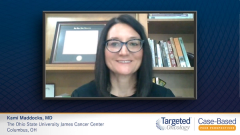
Monitoring for Recurrence in Follicular Lymphoma
Kami Maddocks, MD, highlights what findings may trigger a change in therapy or the introduction of a new agent into a patient’s current treatment.
Episodes in this series

Kami Maddocks, MD: When I treat a patient for follicular lymphoma [FL], if they achieve a complete remission to their initial therapy such as this patient did, I usually follow them every 3 to 4 months. I see them in the clinic, take a good history, do a good physical exam, and then check their labs, CVC [central venous catheter], chemistry panel, LDH [lactate dehydrogenase] for any indications of disease progression. I typically check CT [computed tomography] scans every 6 months for those first 2 years, so monitoring them in the high-risk period. After patients reach that 2 years of follow up standpoint, I usually extend their visits out to 6 months and see them every 6 months through year 5 and then go to yearly. I do CT scans from year 2 to year 5, and sometimes I will do them at most once each year to just get an idea if there’s been any progression.
Otherwise, I just use CT scans if patients call in with symptoms if I detect new lymphadenopathy on exam or if something in their lab is concerning to me. I do not do a routine PET [positron emission tomography] scan for monitoring in FL. I do like to get a PET for their end of therapy, to ensure that they’re negative by PET scan.
Transcript edited for clarity.
Case: A 74-Year-Old Man With Relapsed/Refractory Follicular Lymphoma
Initial presentation
- A 74-year-old man complains of a 6-month history of fatigue, occasional fevers, decreased appetite, fatigue, and an 8-lb weight loss
- PMH: unremarkable
- PE: palpable right axillary and cervical lymph nodes, palpable ~ 3 cm in both locations; spleen palpable 4.5 cm below left costal margin
Clinical Workup
- Labs: ANC 1.6 x 109/L, WBC 11.2 x 109/L, 44% lymphocytes, Hb 9.6 g/dL, plt 98 x 109/L, LDH 315 U/L, B2M 3.5 µg/mL; HBV negative
- Excisional biopsy of the axillary lymph node on IHC showed CD 20+, CD 3+, CD5+, CD 10+, BCL2+; follicular lymphoma grade 2
- Bone marrow biopsy showed paratrabecular lymphoid aggregates, 4% involvement
- Molecular genetics: t(14;18) (q32;q21)
- PET/CT showed enlargement of right axillary, cervical, and mediastinal lymphadenopathy (3.3 cm, 3.1, cm and 4.6 cm respectively)
- Ann Arbor Stage IV; ECOG 0
Treatment
- He was treated with R-CHOP for 6 cycles, achieved complete response and continued rituximab maintenance
- 24 months later he complained of increasing weight loss, fever and drenching sweats as well as more enduring fatigue and new onset itching; he was currently taking antibiotics for his 3rd bacterial infection in the past year
- Repeat PET/CT revealed progression of disease
- He was started on bendamustine + rituximab for 6 cycles and continued on rituximab maintenance
- Repeat lymph node biopsy grade 2 follicular lymphoma
- 12 months later he complained of continued weight loss, increased itching and worsening fatigue; recurrent infections continued
- He was started on idelalisib 150 mg PO BID










































